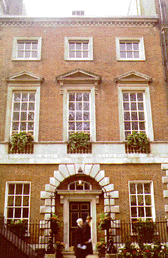William Kent

- 44 Berkeley Square
- [click on the picture to enlarge it]
An enfant terrible of English architecture, William Kent (c.1685-1748) was a versatile artist, a painter, decorator, architect and landscape gardener. After spending ten years in Italy, he lived in London as a member of the circle of Lord Burlington - the patron and architect to whom the success of neopalladianism in England is due. Though he frequently practised the latter style, Kent remained throughout his lifetime an inventive and original architect but never a dogmatic one.
Kent mostly worked for the aristocracy, designing (or redesigning) country houses, parks and pavilions to create homogeneous settings ; his work’s major characteristic is the diversity of styles, from Roman baroque for interior decoration (Houghton Hall, 1726-31, for the statesman Robert Walpole, and Chiswick House, 1726-29, for Lord Burlington) to strict neopalladianism (Holkham Hall, 1734-65) - and even early instances of fanciful “gothick” (Esher, 1733 ; Rousham, 1738-41).
Kent also designed public buildings, having occupied several positions at the Office of Works, and some of his major achievements subsist in London : the Treasury (1733-37) and the Horse Guards (1750-59) in Whitehall. For the royal family, he decorated the palaces of Kensington and St. James’s, built the royal mews, adorned the gardens at Richmond, and even made drawings for a state barge. He also produced original decorations for several town houses (22, Arlington Street, 1741-50 ; 44, Berkeley Square, 1742-44).
A skilful initiator of fashions, Kent also acquired fame defining a new gardening style, more informal than natural, inspired by Italian landscape painting, and integrating fancy architecture with vegetation into scenography. He originated most landscape gardening motifs , later to be developed on a grander scale by Lancelot Brown: irregular lakes, man-made mounds, perimeter belts and clusters of trees, emblematic fabrics. If Stowe (Buckinghamshire) is the largest of the estates on which Kent worked, the suburban gardens of Claremont, Esher, Chiswick et Richmond (all designed after 1730) are amongst his most original productions.
Hogarth’s satires on Kent:

